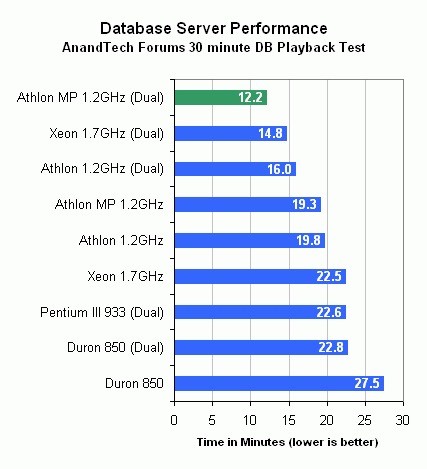AMD 760MP & Athlon MP - Dual Processor Heaven
by Anand Lal Shimpi on June 5, 2001 12:00 PM EST- Posted in
- CPUs
Database Server Performance
In our Intel Xeon review we introduced a new test to our benchmark suite for high-end processors: a Database Server Performance test. The premise behind it was simple; record every single transaction that occurred on the AnandTech Forums Database server for a period of 30 minutes then play it back on a similar server using one of these platforms as fast as possible. This sort of benchmarking is much like a Quake III Arena timedemo where the demo is played back as quickly as possible and an average frame rate is displayed; the only difference here is that instead of an average frame rate, we get a time to complete result instead.
The test remains unchanged from our original review, and for more information about the history behind the benchmark you can read our description of it here.
In order to minimize the I/O bottlenecks the test systems were not only outfitted with four Quantum Atlas 10K hard drives in RAID 0 (offering more write but similar read bandwidth than our Forums DB server's 4 drive RAID 10 array) but they were also given 1GB of memory.
During the 30 minute recording there were: 105267 selects, 4984 updates, 701 inserts and 5 deletes performed on the database. The names of the tasks describe exactly what they are; selects are reads, updates are reads and writes, inserts are writes and deletes remove data from the database (and are quite rare).
The first thing to notice is that the test is extremely read intensive, meaning that the I/O bottlenecks aren't as great as if the test was more write intensive. You can always read faster than you can write so this should mean that the test will be more dependent on a fast platform, provided that it isn't I/O bottlenecked from the start.
If your particular database application is more write intensive the performance results should be similar in terms of the standings of the processors, but the performance gap will be decreased provided that the I/O doesn't change.
The nature of the AnandTech Forums database is that there are very few computational intensive functions performed on the database; most of the functions are straight reads and writes. This places the performance dependency on having a fast platform, not necessarily CPUs with powerful integer/floating point units.
In our original test, the Dual Xeon 1.7GHz platform dominated and we're about to find out how the 760MP when coupled with Dual Athlon MPs stacks up.
If you're not shocked, you should be. AMD's first try at the server market is without a doubt an incredible success, and we've only shown you one real world benchmark this far. A pair of Athlon MPs running at 1.2GHz on the 760MP are able to complete this 30 minute benchmark run in a little over 12 minutes; that's close to 20% faster than the Dual Xeon 1.7GHz system which happens to have over 50% more memory bandwidth.
This test clearly shows you that memory bandwidth isn't all that matters in these systems; factors like FSB bandwidth and even raw CPU power can come into play. If you are looking to upgrade your database server, look no further than the 760MP and a pair of Athlon MPs.
Interestingly enough, there is a fairly large difference between a pair of Athlon MPs and regular Athlons in this benchmark. The regular Athlons are not able to outperform the dual Xeon configuration, while the Athlon MPs do so quite easily. Even more interesting is that this performance difference isn't nearly as pronounced in single processor configurations. Remember that the enhancements made to the Athlon MP core are very data transfer oriented, and with the amount of data processing that goes on when serving content out of a 3GB database it isn't too much of a surprise that the Athlon MP does so well in a DP configuration here.
Another golden nugget to keep an eye on is the Duron. If AMD can ramp up the speed of the Duron, it would make for a great low-cost DB server platform; especially if 760MPX motherboards eventually hit the $200 price point The biggest problem with the Duron being used in a MP system is that a lot of the tasks that MP systems are put to work on are very dependent on having large processor caches; even the 384KB total cache on the Athlon is cutting it pretty close. It will be quite incredible to see what a pair of Athlons with 512KB or 1MB of cache would be able to do, yet all current indications point to the Athlon sticking with 384KB total cache and only the Hammer series (K8) breaking that barrier.
As if the platform and performance alone weren't impressive enough, another major selling point here is the extremely low cost of Registered DDR SDRAM vs. the RDRAM that the Dual Xeon platform requires. You can purchase 1GB of Registered DDR SDRAM for less than $350 while an equivalent amount of RDRAM can be found for more than twice that at around $740. With most of these servers running 2 - 4GB of memory, the savings can add up.











0 Comments
View All Comments